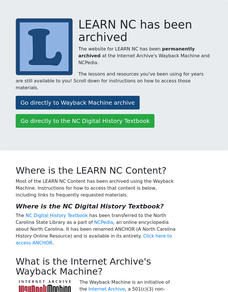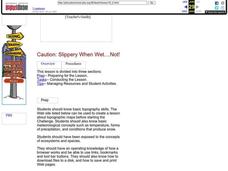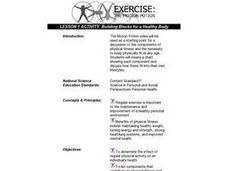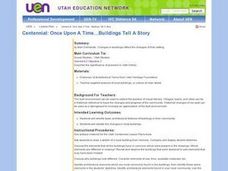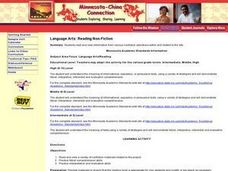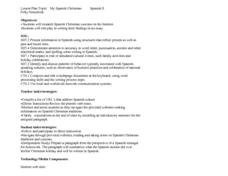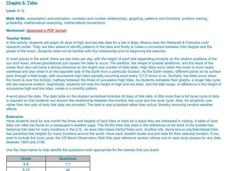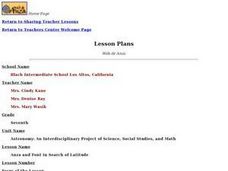Curated OER
A Simple Machines Activity
Fourth graders observe examples of simple machines found in the school, playground, and work environment. In this simple machines lesson, 4th graders review simple machines by viewing three web sites. Students tour the school and grounds...
Curated OER
Personal Written Response Activity
Pupils complete a final written project. In this personal response lesson, students respond in a creative way to one of the issues presented in the unit. Pupils may choose to create a series of postcards from a natural disaster,...
Curated OER
"Three Cool Kids"
First graders discuss literary elements: characters, setting, problem and solution, after reading Three Cool Kids by Rebecca Emberley. The teacher records what students say using Inspiration, making a web that shows the different...
Curated OER
Comparing Fairy Tales
Students read and review common fairy tales and come up with a list of characteristics from them. The Teacher models filling out either a compare & contrast graphic organizer comparing two fairy tales.
Curated OER
STDs
Students list the common types of STDs, HIV/AIDS and their symptoms. They complete worksheets concerning adult roles and responsibilities and determine ways to avoid disease. They use study guides and web sites to examine pertinet...
Curated OER
Inventions and Inventors
Fifth graders investigate an introduction to both Invention Convention and Unit 3 in the Social Studies Book, the teacher will point out that many changes occurred in the United States during the late 1800s and early 1900s.¿¿¿...
Curated OER
Ready, Set, Tech (Primp Up Your Poems: Literary Devices)
Students study literary devices used in poetry. They gain access to a specific Internet poetry site that provides a step-by-step guide on how to write a poem. They each write a poem and then exchange it with others in a group for peer...
Curated OER
Holiday Ideas: Snowman
In this fine motor skills lesson, students cut and paste items onto a snowman with no help from their teacher. Students will use items, such as toothpicks, to help them glue small pieces. Students distiguish between small,...
Curated OER
Breathing Easier
Students explore asthma, and then write proposals outlining how teachers, coaches, administrators and school support staff can be better prepared to treat students with asthma.
Curated OER
Caution: Slippery When Wet....Not!
Students and manipulate data from Internet sites to design a downhill ski course that meets the International Federation of Skiing's requirements for a safe and fair competition.
Curated OER
Mapping Possible Solutions
Fourth graders propose possible sites for the heart of Florida state capital by mapping collected data onto a Florida state map and recording data in a Travel Log.
Curated OER
Friendly Flowers
Students listen to music while creating flowers with a partner. They decide on a philanthropic act related to flowers. They recognize the difference between private property and common resources. They use a problem-solving model to...
Curated OER
Famous African Americans ABC Book
Students create an ABC book with short biographies of famous African Americans in history. They utilize teacher-selected and/or student-researched library sources about African Americans in history.
Curated OER
Building Blocks for a Healthy Body
Students watch a video and discuss the benefits of regular exercise. They use books, Internet sites and interviews with health professionals to develop a list of activities to develop physical fitness.
Curated OER
Centennial: Buildings Tell a Story
Students research which buildings are registered as national or state historical sites, and lobby the community by petition to have another local building placed on the national or state historic register.
Curated OER
Language Arts: Reading Non-Fiction
Students read and view information sent from seven high school students who travel to China. The daily reports that they send back to the weblog section of the site should be of high interest to students in Minnesota.
Curated OER
Trade -- Lesson Plan on the Theory of Comparative Advantage
Twelfth graders examine the theory of comparative advantage. They read an article about globalization and trading to answer questions promoted by the teacher. They develop their own examples of comparative advantage.
Curated OER
Texas Estuary Project
Students take a field trip to a local estuary and analyze water samples. They analyze and graph the data results, write an essay, and create a food web of their field site.
Curated OER
My Spanish Christmas
Tenth graders research Spanish Christmas customs on the interent and role play in their writing their findings in an essay. They teacher provides a list of web addresses for the students to locate information on and from that their...
Curated OER
Corals and Coral Reefs
Young scholars label the continents, oceans, and seas on a provided world map and use it to determine where they would expect most of the world's coral reefs to be found based on provided information the teacher has read to them.
Curated OER
Tides
Students graph 40 days of high and low tide data for a site in Baja, Mexico near the Wetlands & Fisheries Live! research center. They identify patterns in the data and finally to make a connection between tidal heights and the phase...
Curated OER
Anza and Font in Search of Latitude
This is an integrated lesson plan that incorporates Social Studies, Science, and Mathematics. In Social Studies, 7th graders complete an online interview and complete an online worksheet about latitude of sites on the Anza trail. In...
Curated OER
A Mayan Adventure - Special Assignment
Students role-play the role of a reporter for their school's newspaper. Pretending they are visiting Mexico and Central America, they research the answers to questions given to them by their teacher. They discuss their answers and the...
Curated OER
Discovering My Family History
Students research their family trees. They research Internet sites, conduct interviews and, when possible, access primary sources to compile information about their family's history. Students present their findings in a family tree.


